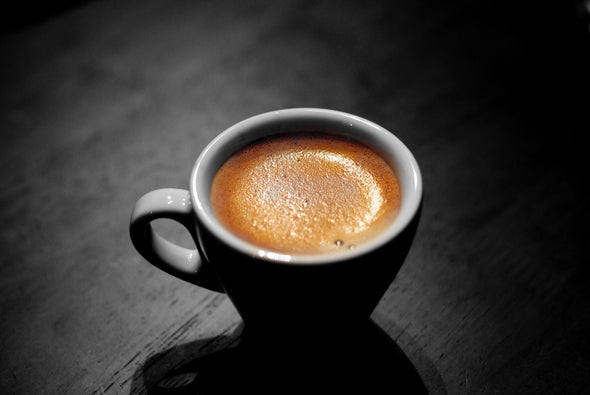(单词翻译:单击)
听力文本
This is Scientific American's 60-second Science. I'm Karen Hopkin.
Making a cup of coffee isn't rocket science. But a new study shows that a background in math and analytical chemistry doesn't hurt. Because researchers who applied their skills in materials science and modeling to brewing espresso have made a grounds-breaking discovery: contrary to popular belief, using fewer beans and a coarser grind will give you a more consistent shot. Their work appears in the journal Matter.
If you're a coffee aficionado, you've no doubt noticed that some days, you may get a great espresso; other days, not so much. Even with the same coffee, the same machine, the same settings.
To understand that variability, the researchers developed a mathematical model to explore how coffee is extracted or dissolved as water passes through the bed of grounds.
"Basically, what we did was to start by writing down some equations, which apply to just a single ground."
Jamie Foster, a senior lecturer in mathematics and physics at the University of Portsmouth.
"So it's a less intimidating task, because in a real coffee bed, you've got millions and millions of particles that are packed together in this very complicated way. And so a more tractable problem is to write down the equations on a single ground."

To model the entire coffee bed, Foster and his colleagues copied that equation millions of times, stirred in a bit more math and then poured on the theoretical water.
"The model tells us what we should expect in an ideal situation when all of the coffee is being contacted by all of the water equally."
Christopher Hendon, a computational chemist at the University of Oregon, who also took part in the study.
"And indeed, the model describes reality very well for particular grind settings, where there is a sufficient amount of large particles so the water can flow freely through that bed. But when you grind sufficiently fine, that's when we started to see, in real life, a divergence from the expectation that the model was telling us."
With the fine grind, some shots were stronger than predicted. But some were considerably weaker, which flies in the face of conventional wisdom.
"The thinking, if you want a stronger cup of coffee, is, well, I'll grind it finer, because by doing that, I'll have smaller particles in my grounds, and the smaller particles will have a higher surface area. And so this high surface area allows for more rapid extraction from the grains."
But what the researchers found is...
"If you kind of overdo the grinding, what ends up happening is: the particles are so small, in fact, that they kind of clog up the gaps where the water's trying to flow. And that actually hampers the extraction rather than helping it."
And the same is true for the amount of coffee you start with—so that less can, counterintuitively, end up tasting like more.
"Since these articles came out, there has been a tremendous amount of activity on Twitter—arguing, discussing, just general excitement and interest in the project. And independent of whether this helps make more reproducible coffee or not, this is a tremendous success—that we have got millions of people to have read a scientific article and engage with science. That's a great success for scientific literacy."
And we can all drink to that.
Thanks for listening for Scientific American's 60-second Science. I'm Karen Hopkin.
参考译文
这里是科学美国人——60秒科学。我是凯伦·霍普金。
煮咖啡并非尖端科学。但一项新研究表明,对于煮咖啡来说,拥有数学和分析化学背景并没有坏处。因为研究人员将材料科学和建模技术应用于煮咖啡后,获得了一个突破性发现:与普遍观点相反,少量咖啡豆和更粗糙的研磨会让咖啡口感更稳定。他们的研究成果发表在《物质》期刊上。
如果你是咖啡爱好者,无疑会发现有时浓咖啡的味道绝佳;而有时却不太令人满意。即使使用的是同一种咖啡豆、同一咖啡机和同样的设置。
为了了解这一变化性,研究人员开发了一个数学模型,以探索当水冲过咖啡粉床时,咖啡被萃取和溶解的方式。
“基本上,我们是从写下仅适用于单个粉床的方程式开始。”
朴茨茅斯大学的数学和物理高级讲师杰米·福斯特说到。
“这个任务不怎么吓人,因为在真实的咖啡粉床中有数百万颗粒以这种非常复杂的方式聚集在一起。因此,写出针对单个粉床的方程更容易解决。”
为了模拟整个咖啡床,福斯特及其同事将方程式复制了数百万次,再搅入一点数学知识,然后注入理论水。
“模型显示,在理想情况下,在所有咖啡被所有水均匀接触时,我们应该期待的效果。”
俄勒冈州大学的计算化学家克里斯托弗·亨登也是这项研究的参与者。
“模型充分描述了颗粒研磨的真实设置情况,即放入数量充足的大颗粒时,水就可以顺畅地流过粉床。但当你将咖啡豆研磨得足够细时,就会开始发现,你预想的情况和模型显示的情况存在偏差。”
精细研磨咖啡豆后,咖啡口味有些比预想的浓郁。但有些味道却相当淡,这与传统观点背道而驰。
“传统观点认为,如果想让咖啡口味更浓郁,就要把咖啡豆磨得更细,因为这样粉床上的颗粒会更小,继而接触面就更大。接触面积大,咖啡颗粒被萃取的速度就会更快。”
但研究人员的发现是:
“如果研磨过度,最后的情况会是:颗粒变得过小,以致于堵住水要流过的缝隙。这实际上是阻碍萃取,而不是有助于萃取。”
同样的道理也适用于开始时的咖啡量,与常识相反,少一点,最终尝起来会像更多。
“自从这些文章发表以来,推特上便出现了大量活动,人们对这个项目进行争论和讨论,这表明了人们对其的普遍兴奋和兴趣。无论是否有助于制造口味更具可复制性的咖啡,这都是巨大的成功,因为我们让数百万人阅读了科学文章,参与了科学研究。就培育科学素养而言,这是巨大成功。”
我们都可以为此举杯祝贺。
谢谢大家收听科学美国人——60秒科学。我是凯伦·霍普金。
译文为可可英语翻译,未经授权请勿转载!
重点讲解
重点讲解:
1. contrary to 与…相反;
Contrary to popular belief, moderate exercise actually decreases your appetite.
与通常的看法相反,适度的运动事实上会降低食欲。
2. no doubt 无疑地;必定;
They would no doubt welcome the action with open arms.
他们无疑将热烈欢迎这一举动。
3. write down 写下;记下;
On the morning before starting the fast, write down your starting weight.
早晨开始禁食前,记下你的体重。
4. fly in the face of 完全违背;与(公认的观念或规则)相冲突;
Such a proposal is flying in the face of common sense.
这个建议违反常识。


